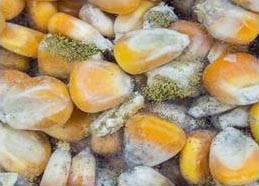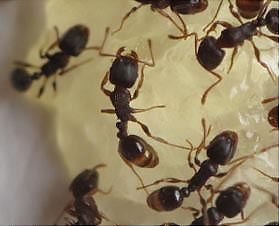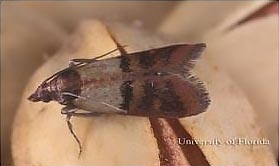Introduction to Aflatoxins

Aflatoxins are poisonous substances produced by certain kinds of fungi (molds) that are found naturally all over the world; they can contaminate food crops and pose a serious health threat to humans and livestock. Aflatoxins also pose a significant economic
burden, causing an estimated 25% or more of the world’s food crops to be destroyed annually. Long-term or chronic exposure to aflatoxins has several health consequences. aflatoxins are potent carcinogens and may affect all organ systems, especially the liver and kidneys.
In the US, aflatoxin is typically identified at the agricultural stage of the supply chain, but it is a hazard requiring identification if it is reasonably likely to occur or could occur in raw materials at a food or feed manufacturing facility. In May 2019 a major animal feed company issued a recall for “Elevated Aflatoxin Levels” in feeds ranging from alpaca feed to goat feed, horse feed, whole and cracked corn and lamb feed.
Heating and cooking under pressure can destroy nearly 70% of aflatoxin in rice compared to under atmospheric pressure only 50% destroyed. The Food and Agriculture Organization (FAO) showed, through their studies, only about 10% of total 1242 ppb of aflatoxin B. decreased in naturally contaminated peanut by heating at up to 212° F Since aflatoxin resists to higher temperatures up to 500° F.
Prevention is the most effective way to control the risks of aflatoxin. Prevention can only be achieved at an agricultural level through crop and field management. Store commodities at low temperature whenever possible. The use of appropriately labeled fungicides and preservatives have shown to be effective against fungal growth. At a manufacturing level, organizations should ensure suppliers are complying with regulations, testing their product I susceptible to aflatoxin, and issuing a certificate of analysis.
Submitted by: Rich Gibson, CHA, ACE
The Pavement Ant

Order: Hymenoptera Family: Formicidae Genus: Tetramorium Species: T. caespitum
The pavement ant, Tetramorium caespitum, is dark brown to blackish, and 2.5–4 mm long. Like other ants there are the workers, alates, and a queen. Alates, or new queen ants and drones, have wings, and are twice as large as the workers. This ant is a common pest, their name comes from the fact that they usually make their homes in subterranean environments, and often under slabs or pavement. They are distinguished by one spine on the back, two nodes on the petiole, and grooves on the head and thorax.
During early spring, colonies attempt to conquer new areas and often attack nearby enemy colonies. These result in huge sidewalk battles, sometimes leaving thousands of ants dead. Because of their aggressive nature, they often invade and colonize seemingly impenetrable areas. In summertime, the ants dig out the sand in between the pavements to vent the nests. These ants will eat almost anything, including insects, seeds, honeydew, honey, bread, meats, nuts, and cheese.
The use of a residual insecticide for ants is a quick fix but is only effective on the visible ant, not the thousands “back home” in the colony. Baits, gel or granular, are more effective as the bait is taken to the colony and shared with the queen.
Submitted by: Rich Gibson, CHA, ACE
Stored Product Pests

RK Environmental Services was recently called into a distribution center that was struggling badly with chronic infestations of stored product insects. The distribution center is in a warm southern state and stores both whole and processed grain products. To make the design of a pest management strategy even more complex, the facility was connected on both sides as part of an industrial complex.
There was regular activity with external feeders and scavengers such as Indian Meal Moths and Sawtooth Grain beetles. There is also sporadic infested whole grain product by internal feeders such as granary weevils or lesser grain borers.
There simply was no easy way to approach this problem and only a comprehensive approach would work. The first step was to conduct a raw material audit, where an identified specific insect pest risks associated with each different raw material. Then a robust inbound inspection process was established with the distribution center. This included Integrated Pest Management (IPM), insect identification training, and how to conduct a thorough inspection.
Next, a systematic monitoring system was implemented and included pheromone traps for flying external feeders and floor dome traps for crawling stored product insects. All devices were inspected weekly and detailed record keeping allowed for RKE service professionals to identify active areas of the distribution center using heat maps and trend reports.
For treatment, scheduled space treatments were performed using a 1% pyrethrin, and preceded by residual applications to expansion joints and legs of storage racks. With the residual applications we also used an insect growth regulator labeled for stored product insects. Because the facility was in a shared industrial complex, fumigation of the space or use of any Vapona product was not an option.
For infested product with internal feeders, a fumigation chamber was established outside of the facility in a secure location. When any infested product was found, it was put into the fumigation chamber and treated with phosphine gas.
This approach needed to be tightly managed, but with full client cooperation and diligent leadership by the RK Environmental service professional, the team was able to manage insect populations and protect the client’s products. Monitoring records and trend reports served as objective evidence that all efforts were successful in controlling the infestation.
- Take Away Tips:
- Teamwork and cooperation are essential
- Insect identification is critical
- Training will lead to success






